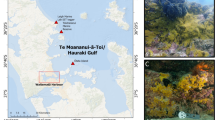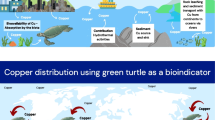Abstract
In October and November of 2010, the gelatinous macroplankton in the northwestern Black Sea and at the Crimean shelf was represented by the scyphozoan jellyfish Aurelia aurita, three species of ctenophores (Beroe ovata, Mnemiopsis leidyi, and Pleurobrachia pileus), and three species of hydromedusae. A. aurita was more common at the shelf, M. leidyi and P. pileus prevailed at the deeper sea stations, and B. ovata was almost ubiquitous with a biomass from below 1 to 49 g/m2 A. aurita, which had an average biomass of 82–224 g/m2, was dominant at all the stations. M. leidyi, which had a biomass from below 1 to 115 g/m2, was recorded in October at only 14 of the 52 stations and in November at 20 of the 46 stations. The highest biomass of M. leidyi in October (105 to 116 g/m2) was recorded in the deep sea areas; in November, it was also the highest in these areas, but it reached at most 100 g/m2. The average daily ration of Aurelia ranged from 19.4 to 27.3 mg/m2 in October and from 7.0 to 17.2 mg/m2 in November; in both cases, it was insufficient to provide for the minimal physiological requirements. The average daily ration of the Mnemiopsis population (2.8–20.5 mg of zooplankton per m2) was invariably more than sufficient to provide for the minimal physiological requirements. Both predatory species together consumed less than 5% of the daily zooplankton production of the sea.
Similar content being viewed by others
References
B. E. Anninsky, G. I. Abolmasova, and N. A. Datsyk, “Influence of jelly raptorial animals on food reserves of small pelagic fishes, 9.2.2. Eat away of mesoplankton by Aurelia aurita L. in the Black Sea,” in Commercial Bioresources of the Black and Azov Seas, Ed. by V. N. Eremeev (EKOSI-Gidrofizika, Sevastopol, 2011), pp. 276–282.
B. E. Anninsky and F. Timofte, “Distribution of zooplankton in Western Black Sea in October of 2005,” Morsk. Ekol. Zh. 8(1), 17–31 (2009).
M. E. Vinogradov, E. A. Shushkina, and G. G. Nikolaeva, “Conditions of zoocene in open regions of the Black Sea by the late summer of 1992,” Okeanologiya (Moscow, Russ. Fed.) 33(3), 382–387 (1993).
M. E. Vinogradov, T. A. Shiganova, and V. S. Khoroshilov, “Conditions of basic elements of plankton community in the Black Sea,” Okeanologiya (Moscow, Russ. Fed.) 35(3), 418–422 (1995).
A. V. Kovalev, V. V. Mel’nikov, N. A. Ostrovskaya, and I. Yu. Prusova, “Mesoplankton,” in Plankton of the Black Sea, Ed. by A. V. Kovalev and Z. Z. Finenko (Naukova Dumka, Kiev, 1993), pp. 183–193.
A. V. Kovalev, Yu. A. Zagorodnyaya, and N. A. Gavrilova, “Study of the Black Sea zooplankton,” in Geological Studies of 47th Cruise of R/V Professor Vodyanitskii in the Black Sea, Ed. by E. F. Shnyukov (Otd. Morsk. Geol. Osad. Rudoobraz., Kiev, 1995), pp. 155–165.
T. S. Petipa, “Average weight of zooplankton in the Black Sea,” Tr. Sevastop. Biol. Stn., Akad. Nauk Ukr. SSR 9, 39–57 (1957).
A. V. Temnykh, Yu. N. Tokarev, V. V. Mel’nikov, and Yu. A. Zagorodnyaya, “Diurnal dynamics and vertical distribution of pelagic Copepoda in open waters of southwestern Crimea (Black Sea) in autumn of 2010,” Morsk. Ekol. Zh. 11(2), 75–84 (2012).
G. A. Finenko, G. I. Abolmasova, N. A. Datsyk, and B. E. Anninsky, “Mnemiopsis leidyi: nutrition rate of sea walnuts in a sea and food burden on zooplankton,” Morsk. Ekol. Zh. 9(1), 73–83 (2010).
G. A. Finenko, Z. A. Romanova, G. I. Abolmasova, B. E. Anninsky, T.V. Pavlovskaya, L. Bat, and A. Kideys, “Ctenophores invaders and their role in the trophic dynamics of the planktonic community in the coastal regions off the Crimean coasts of the Black Sea (Sevastopol Bay),” Okeanologiya (Moscow, Russ. Fed.) 46(4), 472–482 (2006).
E. A. Shushkina and G. N. Arnautov, “Jellyfish Aurelia found in the Black Sea plankton in May 1984,” in Current Condition of the Black Sea Ecosystem, Ed. by M. E. Vinogradov and M. V. Flint (Nauka, Moscow, 1987), pp. 186–196.
E. A. Shushkina and M. E. Vinogradov, “Changes in plankton communities of open waters of the Black Sea affected by Mnemiopsis (1978–1989),” in Variability of the Black Sea Ecosystem Caused by Natural and Anthropogenic Factors, Ed. by M. E. Vinogradov (Nauka, Moscow, 1991), pp. 248–262.
E. A. Shushkina and E. I. Musaeva, “A role of jellyfishes in activity of plankton communities in the Black Sea,” Okeanologiya (Moscow, Russ. Fed.) 23(1), 125–130 (1983).
B. E. Anninsky, “Organic composition and ecological energetics of jellyfish Aurelia aurita L. (Cnidaria, Scyphozoa) under the Black Sea conditions,” in Trophic Relationships and Food Supply of Heterotrophic Animals in the Pelagic Ecosystem of the Black Sea, Ed. by G. E. Shulman, et al. (Black Sea Comm. Publ., Istanbul, 2009), pp. 99–160.
B. E. Anninsky, A. E. Kideys, Z. A. Romanova, et al., “The ecological and physiological state of the ctenophore Mnemiopsis leidyi (Agassiz) in the Black Sea in autumn 1996,” in Ecosystem Modeling as a Management Tool for the Black Sea, Ed. by L. I. Ivanov, T. Oguz et al. (Kluwer, Dordrecht, 1998), Vol. 1, pp. 249–262.
K. Barz and H.-J. Hirche, “Seasonal development of scyphozoa medusae and predatory impact of Aurelia aurita on the zooplankton community in the Bornholm Basin (central Baltic Sea),” Mar. Biol. 147, 465–476 (2005).
G. A. Finenko, B. E. Anninsky, G. I. Abolmasova, et al., “Functional role of the ctenophores-invaders Mnemiopsis leidyi Agassiz and Beroe ovata Mayer in inshore planktonic communities,” in Trophic Relationships and Food Supply of Heterotrophic Animals in the Pelagic Ecosystem of the Black Sea, Ed. G. E. Shulman, et al. (Black Sea Comm. Publ., Istanbul, 2009), pp. 161–221.
L. J. Hansson, O. Moeslund, T. Kiørboe, and H. U. Riisgärd, “Clearance rates of jellyfish and their potential predation impact on zooplankton and fish larvae in a neritic ecosystem (Limfjorden, Denmark),” Mar. Ecol.: Prog. Ser. 304, 117–131 (2005)
A. E. Kideys and Z. A. Romanova, “Distribution of gelatinous macrozooplankton in the southern Black Sea during 1996–1999,” Mar. Biol. 139, 535–547 (2001).
A. Malej, V. Turk, D. Lučić, and A. Benović, “Direct and indirect trophic interactions of Aurelia sp. (Scyphozoa) in stratified marine environment (Mljet Lakes, Adriatic Sea),” Mar. Biol. 151, 827–841 (2006).
H. Möller, “Scyphomedusae as predators and food competitors of larval fish,,” Meeresforsch. 28, 90–100 (1980).
E. Mutlu, “Distribution and abundance of cteno-phores, and their zooplankton food in the Black Sea. II. Mnemiopsis leidyi,” Mar. Biol. 135, 603–613 (1999).
E. Mutlu, F. Bingel, A. C. Gücü, et al., “Distribution of the new invader Mnemiopsis sp. and the resident Aurelia aurita and Pleurobrachia pileus populations in the Black Sea in the years 1991–1993,” ICES J. Mar. Sci. 51, 407–421 (1994).
B. Öztürk, V. Mihneva, and T. V. Shiganova, “First records of Bolinopsis vitrea (L. Agassiz, 181860) (Ctenophora: Lobata) in the Black Sea,” Aquat. Invasion 6(3), 355–360 (2011).
J. E. Purcell, “Climate effects on formation of jellyfish and ctenophore blooms,” J. Mar. Biol. Assoc. UK 85, 461–476 (2005).
J. E. Purcell, S. -I. Uye, and W. -T. Lo, “Anthropogenic causes of jellyfish blooms and direct consequences for humans: a review,” Mar. Ecol.: Prog. Ser. 350, 153–174 (2007).
A. J. Richardson, A. Bakun, G. C. Hays, and M. J. Gibbons, “The jellyfish joyride: causes, consequences and management responses to a more gelatinous future,” Trends Ecol. Evol. 24(6), 312–322 (2009).
T. A. Shiganova, J. V. Bulgakova, S. P. Volovik, et al., “A new invader, Beroe ovata Mayer 1912 and its effect on the ecosystems of the Black and Azov seas,” Hydrobiologia 451, 187–197 (2001).
D. Stoecker, A. E. Michaels, and L. H. Davies, “Grazing by the jellyfish, Aurelia aurita, on microzooplankton,” J. Plankton Res. 9, 901–915 (1987).
B. K. Sullivan, J. R. Garcia, and G. Klein-MacPhee, “Prey selection by the scyphomedusan predator Aurelia aurita,” Mar. Biol. 121, 335–341 (1994).
Author information
Authors and Affiliations
Corresponding author
Additional information
Original Russian Text © B.E. Anninsky, G.A. Finenko, N.A. Datsyk, S.M. Ignatyev, 2013, published in Okeanologiya, 2013, Vol. 53, No. 6, pp. 758–768.
Rights and permissions
About this article
Cite this article
Anninsky, B.E., Finenko, G.A., Datsyk, N.A. et al. Gelatinous macroplankton in the Black Sea in the autumn of 2010. Oceanology 53, 676–685 (2013). https://doi.org/10.1134/S0001437013060015
Received:
Accepted:
Published:
Issue Date:
DOI: https://doi.org/10.1134/S0001437013060015




